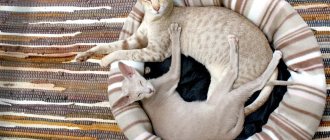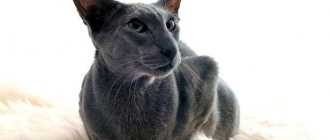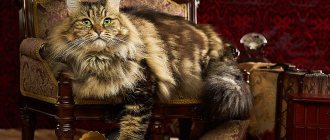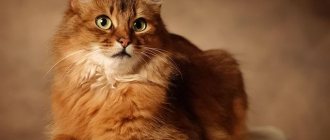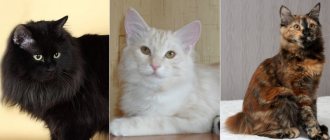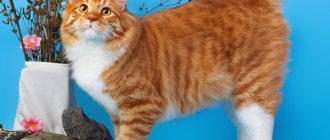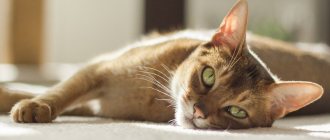| Country of origin | Thailand, UK |
| Dimensions and weight | 4-6.5 kg, length - 60 cm |
| Wool | short, there is a semi-long variety |
| Lifespan | 13-16 years old |
Graceful, slender, sophisticated, incredibly flexible - that's all she is - an oriental cat. But the apparent fragility of these animals is combined with excellently developed muscles and a love of movement. Orientals belong to the Siamese-Oriental group of cats. Therefore, representatives of the breed are often called “Asians”, “Orientals”, “Oriental”, “Orik”, “Ori”. There are other names, some of them are already outdated: cat greyhound, shorthaired pointer, oriental shorthair.
History of the breed
The Oriental Shorthair is a cousin of the Siamese cat. More precisely, it is one breed, but with different colors and eye colors. Siamese have a light body, blue eyes, Orientals have a fully colored body and green eyes. There are no more differences, not even in character.
In ancient Thailand, the Oriental cat was one of the varieties of Royal Siamese cats, which were revered in the imperial palace and temples.
Part I
The ancestors of the Siamese and Orientals were brought from Thailand to England at the same time (late 19th century). There is information that at an exhibition in London in 1896, an oriental cat of a solid blue color was presented. But she was disqualified because there was no Siamese color. The popularity of the Siamese with its point coat and blue eyes has eclipsed the Orientals. And in 1923, the British Siamese Cat Club finally excluded solid green-eyed cats from the Siamese class. All activities related to breeding the breed were stopped.
Part II
After World War II, as the Siamese population declined, some breeders returned to breeding colored cats. First, work began on breeding chocolate-colored oriental cats, which were given the name Havana. A number of historians claim that the shade of the wool is comparable to the rich color of a Havana cigar, hence the name. Then they started breeding lilac orientals, with different colors and patterns.
Part III
An equally interesting story began in America. In 1956, the chocolate cat ended up in California (USA), where they almost immediately began to recognize it as a new breed. In 1964, the CFA approved the independent Havana Brown breed, giving it champion status. Therefore, in Europe, Havana Brown is a chestnut color, and in America it is a separate breed. The same story happened with white Asians, who in 1974 received breed status under the name “Foreign White”.
To obtain new colors, breeders infused Asian cats with the blood of American Shorthair, Abyssinians, Burmese, and Russian Blues.
After this, a campaign began to recognize solid Siamese cats as a separate breed. Already in 1977 the standard was approved. This year and the next, the Oriental breed was at the peak of its fame, entering the top ten most popular. The only exception was for cats with bicolor colors. But in 1995, justice triumphed - the color was recognized.
Oriental semi-longhair cats
In the 80s In the 20th century, oriental cats with long hair, called British Angora, were registered in England. The breed was recognized by the largest felinological system - GCCF. In 2003, the name was changed - the British Angora became the Oriental Longhair.
In America, a cat with silky long hair, a feathered tail and a small beard was the result of crossing a shorthaired Oriental and a Balinese. The kittens received a Balinese build and semi-long hair, but the color remained oriental. In 1997, Oriental Longhair was recognized in the USA.
The Oriental Longhair breed has other names - Oriental Longhair, Mandarin.
Description of the breed
The appearance of the oriental cat provided another interesting name - “greyhound of the cat world.” A beautiful, graceful body, long legs, a whipping tail, an elongated muzzle with expressive eyes and large ears make the image of the Oriental recognizable.
The standard is very similar to the Siamese breed standard. Only in the description of the head and body the word “medium” was replaced with “long”. And also, unlike the Siamese and Thai cats, the fur of Orientals does not change tone due to climatic conditions and hormonal changes.
The Oriental breed is a medium-sized cat. As with other breeds, males are much larger than females. So, the average weight of a male is 4.5-6 kg, a female weighs 3-3.7 kg. Body length without tail is on average 60 cm, height – up to 35 cm.
The standards of the leading felinological systems differ little from each other when assessing the Oriental breed.
Breed standard:
| Become | Description |
| Head | The skull is a well-defined wedge. The nose is straight and long. There is no transition from nose to forehead. The chin is strong, strong, but not massive. The neck is long and slender. |
| Ears | Wide at the base, tapering towards the tip. Set low and wide. The size is very large. The tips of the ears should not droop. |
| Eyes | They are shaped like almonds. The color is rich green without inclusions. An exception is for white orientals, in which blue or different colors are acceptable. |
| Body | Elongated, toned, with well-developed muscles. Shoulders are no wider than hips. |
| Legs | Slender, long, with developed muscles. The hind legs are longer than the front ones. Thanks to this, Orientals are distinguished by their jumping ability. Small, oval paws. |
| Tail | Thin, sharp at the tip, without creases or knots. The length is in harmony with the body, reaching the shoulder blades or a little further. |
| Wool | Very short, silky (with a satin effect), close to the body. There is no undercoat. The Oriental Longhair cat has flowing, fine fur. Because the hairs fit tightly to the body, the fur appears shorter than it actually is. |
Rainbow colors
Representatives of the Oriental breed have more than 300 color varieties. For such abundance, the Oriental Shorthair received the nickname “rainbow cat.”
With all the variety of colors, patterns and types, the color of the eyes is exclusively green.
Solid colors
- Ebony (ebony). One of the most beautiful, making the cat look like a black panther. The fur is completely jet black from tip to root, without a hint of rusty hairs. The same black paw pads and tip of the nose.
- Chestnut (chocolate, Havana). Uniform, warm chestnut brown color. An animal with a Havana coloration looks very exotic.
- Lavender (lilac). The fur is pink-gray, as if covered with frost. But the color should not be too blue or fawn. The nose and paw pads are pinkish-lilac.
- Blue. The coat is uniformly blue, without a hint of silver or rust. The paw pads and nose are the same.
- Red. Monochromatic, no patterns or shades.
- Cream. Pure color preferably light tones.
- Tortoiseshell. There are spots scattered all over the cat's body. This happens if the main coat color is diluted by a red or cream color.
- Faun. Light beige color, which is called the “color of a young fawn.”
- Cinnamon (cinnamon color). All chocolate brown tones: brown, sandy brown (not red) with copper or bronze undertones. Markings may be visible on light coats - this is acceptable, but preference is given to a richer, purer color.
- Smoky. A variation when, with the main or tortoiseshell color, the lower part of the hairs remains white due to the lack of pigment.
- White. Pure white color without a hint of yellowness. The eyes of such cats can be blue, green, or one blue, the other green.
Tabby colors
Patterned colors such as brindle, harlequin, ticked, and spotted are common. All varieties are characterized by the letter M on the forehead, lines from the outer corners of the eyes to the back of the head, several necklaces on the neck, 2 rows of dots running along the chest and stomach. Rings cover the legs and tail.
Varieties of patterned colors:
- Brindle. A narrow continuous line runs from the back of the head to the tail. The entire body is covered with stripes running from the spine to the lower abdomen.
- Spotted. It is similar to a brindle, but the longitudinal and transverse stripes are divided into spots of different shapes - round, oval.
- Marble. Lines run from the head to the shoulders, forming a butterfly-shaped pattern. Three parallel lines can be traced along the back from the “butterfly” to the base of the tail. On each side there are spots symmetrically located, surrounded by one or more rings.
- Ticked. There is no pattern on the body, but each hair consists of alternating areas of dark and light color.
Famous colors of Orientals
Based on the color of the Oriental cat’s fur, the cats themselves are treated differently. For example, black cats are called panthers, as many say, this is due to the fact that representatives of the black color have a clearly oriental coloring of a black panther and green, expressive eyes.
Black oriental cat
The next colors are Havana, which is named after the house cigars, and is a brown oriental.
Havana - color of an oriental cat
Other colors of Oriental Shorthairs have similar names. As they say, each of the cat colors presented is original and unique, with its own fans and group of cat lovers who admire the palettes. The variety of colors really surprises viewers of different categories. The rarest pets have bluish tints, sometimes with gray tints.
Blue oriental cat
There are pink tones, with shimmering soft purple hues. The most exotic varieties of Orientals are, as a rule, precisely the primary colors of this breed. The most popular among Oriental cats are the owners of the tabby pattern (a set of interesting, original decorations applied to the main color) - see photo.
Tabby - oriental cat
The tabby variety is divided into several categories: brindle tabby, marbled tabby, spotted tabby. Marble colors are recognized very often, the reason for this lies in the basis of a recessive gene inherent in the offspring, so similar tabby kittens are rarely found in the species. On the outside, the marbled cat is very beautiful and unique: stripes along the length of the entire body that embellish and highlight the thin, graceful, muscular torso of the pet.
And newly born kittens resemble a cute little chipmunk with cute long stripes. Marbled tabbies also come in a variety of coat colors with different spots throughout the body. Some of them are leopard-print cats.
Looking at them, you can find many similarities with their wild ancestors, just as cats themselves are a proportionately smaller version of leopards. Recently, a new subgroup of Oriental Shorthair breeds has emerged, including pets in smoky, silvery tones. The basis on which the colored tabby is built is a uniform color pattern. The more tabby representatives there are of uniform color palettes, the more valued the cat is.
If you decide to buy a good and faithful friend who will become an excellent assistant and will sincerely love you, we suggest you read the tips on how to choose a representative of the Oriental Shorthair breed as a pet.
Character of an oriental cat
All oriental cats have a unique character. Orientals are no exception. Developed intelligence, intelligence, quick wit, affection for the owner, playfulness, talkativeness and eternal busyness - these are the main characteristics of the breed. And the behavior is called nothing less than “dog-like.”
Orientals are one of the most talkative cats. These are very emotional animals. They are not shy about purring, purring loudly just to express their feelings. But not idle. If a cat purrs, it means he needs to speak out: perhaps something hurts, or he is scared or, conversely, happy. Any action does not take place silently, but is accompanied by “conversation.” He will not shake the air while no one is home. He needs a person to communicate.
It is not known what Orientals love more - chatting or being close to the owner. Ori are loving, and become so attached to their owner that they can become depressed if he is absent for a long time. This breed is recommended for people who spend most of their time at home. Either take 2 cats into the house at once or get some other pet. Orientals are friends with everyone. They get along well with children and enjoy playing with them. Get along well with other animals. The adjustment period takes very little time. They find a common language quite quickly even with a dog. Only first they will try to take the position of leader. If the dog does not agree, conflict cannot be avoided. Here the owner’s task is to help make friends between the cat and the dog.
Eastern cat and its features
The name of the representatives of the breed gives some idea of themselves, because from English “oriental” is translated as “eastern”, which makes the cat a rather mysterious breed.
Indeed, it is extremely difficult to find cats similar to oriental ones, because our world does not know many oriental species. For example, consider the Eastern Siamese, which, as an Oriental Shorthair breed recognized by the cat fanciers' association, has the distinguishing feature of only coat colors and different colored eyes. Also, compared to Siamese cats, the Oriental cat is distinguished by the absence of any special darker markings on the tail, face and paws that distinguish the Siamese cat from other cats. The Oriental cat has a uniform coat of pure colors throughout its body. Many features of these cats represent the best - taken from wild genetically inherent qualities, for example, Oriental cats are graceful, have a relief constitution, long and flexible bodies.
According to their conformational characteristics, oriental cats have long, elegant legs and a beautiful, rounded head. The cute, attractive face has large, expressive almond-shaped eyes and medium-sized ears. Cats captivate others with their proud posture, graceful plasticity of movements, grace and elegance.
Oriental
When buying a pet Oriental animal, you get, first of all, a friend who can be trained very well, since the Oriental cat carries out most of the complex commands, because cats also have high intelligence. The pet is immediately attached to its owners, sociable, sincerely loves and trusts. Your representative of the Oriental Shorthair will always find something to do and entertain himself; cats are quite curious, so almost everything that happens around them will be examined and investigated.
Pets will be members of your family, always helping and maintaining friendliness. If small children live nearby in a house where cats live, then oriental cats will happily entertain the children by playing with them. They do not understand that the baby wants to sleep and is generally still too small; they will persistently try to climb into his crib. Therefore, if you have a newborn baby, it is better not to adopt an oriental cat. She will be a great friend and playmate for older children.
Training a pet is in many ways perceived as a game, so the owner can easily teach the pet to perform many exciting commands.
Show cats that it is best to walk on a leash, due to their excessive activity and the danger of running away. While playing on the street, a cat of an oriental breed can easily be taught the “Fetch” command, by which it brings some object, a stick or a ball, thrown by the owner. Other inhabitants of the house or street where Oriental Shorthair cats live will definitely become friends, because the Oriental cat is a conflict-free cat, peace-loving and friendly.
Care and maintenance
Oriental cats do not require any special care. However, it is up to the owner to ensure that the pet lives longer, is healthy and happy.
The Oriental needs daily exercise and play that stimulates its natural instincts to hunt and explore. Therefore, it is better to keep your cat's body and mind active, otherwise behavior problems may develop.
In addition, due to their activity, Orientals are the cats that fall out of windows more often than others. Therefore, when keeping an apartment above the 2nd floor, nets on the windows and a glazed balcony are required.
Grooming
The lack of undercoat and short hairs do not cause trouble to the owner. Of course, Orientals also shed. But it is enough to comb them periodically with a rubber brush or a special glove. There is practically no wool on clothes or furniture. Mostly it accumulates in the resting place.
Tangerines have a small undercoat, which gives them more wool. Brush the animal 1-2 times a week, every day during shedding.
Water treatments
Orientals are bathed only when they are heavily soiled, for example, by accident, or before an exhibition. Most cats do not like to bathe, and the Oriental is no exception. It is important after washing to prevent the animal from getting into a draft.
Nail care
Claw trimming is carried out every 2 weeks. But these terms are arbitrary; some pets will need to do this every 10 days, others – once a month. The procedure is carried out with a special tool (nail clipper) so as not to damage the claws.
Care for ears, eyes, teeth
An obligatory part of care is cleaning the ears, eyes and teeth. They are accustomed to the procedure from infancy, otherwise the cat will resist.
Wipe the ears and eyes with a cotton pad soaked in warm boiled water or a special lotion.
Cats don't take very good care of their teeth. Without additional help from the owner, there is a risk of dental disease. Typically, it all starts with plaque, which should be combated by regular brushing.
Deworming
Prevention of worms is a mandatory procedure. It is carried out 10 days before vaccinations and preferably every six months. There are a lot of deworming drugs. The dosage of almost all is selected by weight. Veterinarians recommend choosing complex medications that act on different types of worms.
Toilet issue
All kittens in the nursery are already litter box trained. And at first it is better to use the same type of tray that the breeder had. This way the kitten will adapt faster and learn to go to the right place.
Orientals love to dig. Therefore, it is better to choose a tray with high sides or a toilet-house. Any filler your pet likes.
How long do oriental cats live?
Oriental cats have a fairly typical lifespan for felines - an average of 5 years, but there are also centenarians. With proper care, nutrition, and the absence of genetic diseases, the Oriental, without losing its playfulness, can live up to 20 years.
Is the Oriental cat hypoallergenic?
The Oriental Shorthair has short hair, so it does not shed as much as other breeds. Researchers also believe that Orientals produce less protein, which is the main allergen. These 2 facts became the basis for including the Oriental cat in the list of hypoallergenic breeds. However, no breed is 100% allergen-free.
Catering
The main requirement for food is its balance.
Recommended food
If you are a busy person, then it will be easier to feed your pet with industrial ready-made food. They are conventionally divided into 4 groups: holistic, super premium food, premium food and economy class.
Holistics
Holistics are more expensive than others, but they are also better in composition. They do not use synthetic preservatives, wheat flour, corn, or vegetable protein ingredients. Contains only the best: fresh and dehydrated fish fillets, meat; peas, rice and lentils as sources of protein, and dried vegetables and fruits as sources of fibre. In addition to the above, there are also vitamin and mineral supplements. Examples of holistic feeds: AATU, Farmina N&D, Now Fresh.
Super premium class
Super premium food is somewhat lower in quality and the price of the product is noticeably lower. Ingredients: a good vitamin and mineral supplement, natural preservatives, while the percentage of meat ingredients is lower, as well as fewer sources of carbohydrates. Examples: Leonardo, Duke's Farm, Pronature Original.
Premium
Advantages of premium food: natural additives; low price; more meat than in cheap analogues; There is food for both kittens and adult cats, as well as for animals with diseases. Disadvantages: rather low meat content; a large proportion of plant components; the presence of dyes and flavors. Examples: Brit Premium, Royal Canin, Pro Plan.
Economy
Economy line food is bought by people who either cannot allocate a certain amount to feed a cat, or who do not know the truth about them. Their only advantage is their low price, but there are many more disadvantages! Firstly, the basis is corn and cereals, and exact descriptions and percentages are not indicated. Secondly, dyes and flavor enhancers are used. And finally, thirdly, these foods are poor in protein.
Below are recommended premium and holistic foods; links with food names are clickable. Using them, you can, within our website, read descriptions of food and read reviews from owners of the Oriental cat breed.
| Super premium | Premium | Holistic |
| Meowing Heads | Science Plan | Carnilove |
Natural products
If your choice is natural nutrition, consider the following.
Orientals love to eat, but are prone to being overweight. The permissible daily calorie intake for cats is 300 kcal, for females – 250 kcal. Babies up to 2 months are fed at least 5 times a day, from 2 to 4 months - 4 times, from 4-6 months - 3 times, over six months - in the morning and in the evening. Food should be at a comfortable temperature: not hot, but not from the refrigerator.
Be sure to include in your diet:
- Beef, lamb or rabbit: 3-4 times a week, 100-120 g;
- Chicken meat: every day;
- By-products (stomachs, heart, liver, chicken necks), minced: 1-3 times a week;
- Fish (trout, cod, salmon, hake, salmon): once a week for cats and 1-2 times for cats;
- Milk (boiled): for kittens up to 3 months, pregnant and lactating cats;
- Egg yolk, whole quail egg: 2 times a week.
- Porridge (rice, oatmeal, buckwheat, wheat): daily;
- Liquid semolina porridge - for kittens up to 3 months;
- Fermented milk products (low-fat cream, cottage cheese, sour cream, natural yogurt, kefir): possible every day;
- Cheese (unsalted): once a week;
- Boiled or fresh vegetables (beets, carrots, cauliflower, cucumbers, green beans): 4-5 days a week;
- Sprouted wheat grains, spinach, salad: 2 times a week;
- Brewer's yeast (dry): 3-4 times a week;
- Vegetable oil (half a teaspoon per porridge): every other day;
- Special supplements with vitamins and minerals: as recommended by a veterinarian.
The cat should always have access to fresh and clean drinking water. Do not pour tap water that is cold or contaminated. Change the liquid 2 times a day: morning and evening.
Oriental cats should not be given:
- Pork, lamb, duck and geese meat;
- Chicken bones, fish bones;
- Sweets: chocolate, marmalade, marshmallows, honey, cakes, etc.;
- Salt, spices, sauces;
- Baked goods (bread, cakes, pastries, etc.); human canned food and sausages;
- Smoked, salty, sweet dishes;
- Potatoes, soybeans, beans (with the exception of asparagus); human vitamins and supplements.
Photo of an oriental breed cat during rest hours)
Feeding
Orientals value a fit and muscular body, so they should not be overfed. But representatives of the breed are big food lovers. They will constantly demand food. If the owner refuses for some reason, then theft has not yet been abolished. They will find it, steal it, eat it. Therefore, you cannot follow the lead. One or two “begged” treats and the oriental will already “twist the ropes” out of the owner, and begging for a tidbit will become a habit. However, excess weight in cats not only spoils their appearance, but also causes health problems.
Natural nutrition
Orientals are not picky when it comes to food, but the diet must be balanced. This is not easy to achieve with natural feeding. However, if the owner is a supporter of natural nutrition for his pet, then when preparing and calculating the dosage, the following must be taken into account:
- A cat consumes 5 to 10% of its own weight per day in food. Kittens and young pets eat more, but with age the appetite becomes moderate. Of course, everything is individual, the main thing is that the cat gets enough to eat.
- As a percentage, daily feeding is 3https://68koshek.ru/soderzhanie/pitanie/perevesti-koshku-na-drugoj-korm0% meat (chicken, veal, chicken stomachs, hearts, necks), 25% vegetables (zucchini, pumpkin, carrots), 20% porridge (rice, buckwheat), 25% fermented milk products (cottage cheese, kefir, fermented baked milk, yogurt, yogurt).
- All new products are introduced into the diet carefully to avoid problems with the gastrointestinal tract and the development of food allergies.
Breeder's choice
You want your Oriental cat to be happy and healthy so you can spend quality time with him, so be prepared before you bring him home. For more information about the history, personality, and appearance of the Oriental, and for advice for breeders, visit the Oriental Shorthair Cat websites, Cat Breeder Advice List, or the International Cat Association.
A reputable breeder will abide by a code of ethics that prohibits the sale of Oriental cats to pet stores and wholesalers, and also has a breeder's responsibilities to their cats and customers. Choose a breeder who has received the health certifications needed to screen for genetic health problems to the greatest extent possible, and one who raises kittens at home.
Kittens that are isolated may become fearful and moody, and may have difficulty socializing later in life.
Many reputable breeders have websites so you can determine who is a good breeder and who is not. Whether you plan to get your feline friend from a breeder, pet store, or other source, don't forget the old saying, "measure twice." Bad breeders and unhealthy nurseries are difficult to distinguish from reliable ones.
There is no 100% guaranteed way to ensure that you will never buy a sick kitten other than doing some research on the Oriental cat breed first (so you know what to expect), checking the premises (to look for unhealthy conditions or sick animals) and asking the right questions. can reduce the likelihood of getting into a catastrophic situation.
And take the time to visit your nearest veterinarian, who can refer you to a reputable breeder or breed rescue organization or other reliable source for purchasing healthy kittens. Put at least as much effort into researching your kitten as you would into choosing a new car or expensive appliance. This will save you money in the long run.
Be patient. Orientals are popular and most breeders have waiting lists. If you have your heart set on a kitten of a certain color or pattern, you may have to wait six months or more for it to arrive. Many breeders will not release kittens to new homes until they are 12 to 16 weeks old.
Before you buy an Oriental kitten, consider whether an adult Oriental might be the best choice for your lifestyle. Kittens are a lot of fun, but they also get into a lot of mischief and can be destructive until they reach somewhat calmer adulthood. If you are interested in purchasing an adult cat rather than a kitten, ask breeders about purchasing a stud or stud cat, or maybe they know of an adult cat that needs a new home.
Adopt a kitten or cat from a shelter
A breeder is not the only option for purchasing an Oriental cat. Although an Oriental kitten is almost never found in shelters, adult Orientals, both purebred and mixed, may not always be so lucky. You can find the perfect Oriental for your family by asking breeders if they know of any Orientals that need a new home, contacting Oriental breed rescues, or checking your local shelters.
Health
Shorthaired Orientals and Mandarins have excellent health and strong immunity. But there is still a predisposition to certain diseases:
- Gingivitis is an inflammation of the gums that, without timely treatment, develops into periodontal disease.
- Cardiomyopathy is a heart disease in which the walls of the ventricle harden. The volume of the heart chambers decreases, which leads to the development of heart failure.
- Retinal atrophy is a hereditary defect in which the visual cells of the retina are destroyed, which leads to partial or complete blindness. The disease occurs both at a young age (3-4 months) and at a later age (after 4-5 years).
- Flat chest syndrome is a hereditary pathology. The chest becomes flat or funnel-shaped. The problem is identified immediately after the kitten is born.
Health of Orientals
All cats are at risk for developing genetic health problems, just as all humans have the potential to inherit a certain disease. Any breeder who claims that the breed they carry does not have health problems or genetic problems is either lying or does not know about the breed. Run from any breeder who does not provide a health guarantee on kittens, who tells you that the breed is 100% healthy and has no known problems, or who tells you that his kittens are isolated from the main body of the breed and have no inherent health problems. health and cannot confirm his words with veterinarians’ opinions. Orientals in general do not have major health problems.
Health problems that can affect Oriental cats are the same as those that affect Siamese cats and include an inherited neurological defect that causes strabismus, hereditary liver amyloidosis, which can lead to liver failure; dilated cardiomyopathy, a condition that reduces the heart's ability to pump.
Both purebred and mixed breeds have a variety of health problems that may be genetic. The same problems that can affect Siamese can also affect Oriental cats, including the following:
- Amyloidosis, a disease that occurs when a type of protein called amyloid is deposited in organs of the body, primarily in the liver of the Siamese family members.
- Asthma/bronchial disease
- Congenital heart defects such as aortic stenosis.
- Crossed eyes.
- A neurological problem that can cause cats to overgroom themselves, resulting in hair loss and frantic behavior, especially when touched or petted.
- Lymphoma
- Nystagmus, a neurological disorder that causes involuntary rapid eye movement.
- Progressive retinal atrophy, for which a genetic test is available.
Bladder stones and mast cell cancer have also been reported in the breed. Never buy a kitten from a breeder who does not provide a health guarantee. A guarantee does not mean that your kitten will never get any of these diseases, but it does indicate a breeder who is willing to stand behind what they produce.
It's a good idea to keep your Oriental indoors only to protect it from diseases spread by other cats, dog attacks, and other dangers outdoor cats face, such as being hit by a car. Orientals that go out also run the risk of being stolen by someone who would like to have such a beautiful cat without paying for it.
Pros and cons of the breed
According to reviews from owners, the Oriental breed has many advantages, but there are also disadvantages, if you can call them that.
Good companion
Gets along well with children and other animals
Loving, affectionate, gentle
Easy to learn and trainable
Very talkative, she will definitely insert her meow on every occasion
Can be annoying, as it follows the owner's heels
Unable to remain alone for long periods of time
How to choose a kitten
When choosing and purchasing a purebred Oriental kitten, it is important to know:
- The breeder will not give away the kitten until it is 3 months old. If they sell smaller kittens, this is a reason to think about it.
- Each purebred kitten must have a birth certificate (birth certificate) or pedigree if it is a show kitten. A pet without documents is not a real Oriental.
If you have doubts whether the litter has been registered, you can always check with the club in which the nursery is listed.
At the age of 2 months, the litter is assessed (actuation). Kittens are divided into 2 categories: those who participate in further breeding and those who do not. The cost of the kitten depends on this. On average, it starts from 20 thousand rubles.
There are too many factors that influence the price. The main one is the type of kitten. The extreme type is valued higher - eared, with a long muzzle, thin bones, and very short hair. All breeders strive to get just such kittens. The price for them starts from 40 thousand rubles. Of course, the cost is determined by color, quality (the presence of defects reduces the cost), and the purpose of purchase (for breeding or castration). Therefore, the price for a kitten as a pet can be 100 thousand rubles, and with the right of breeding 120 thousand and more.
